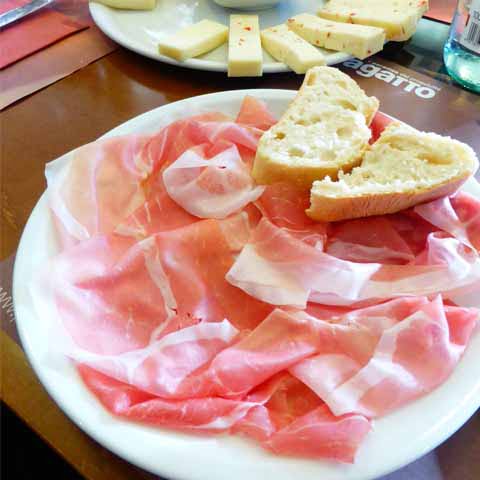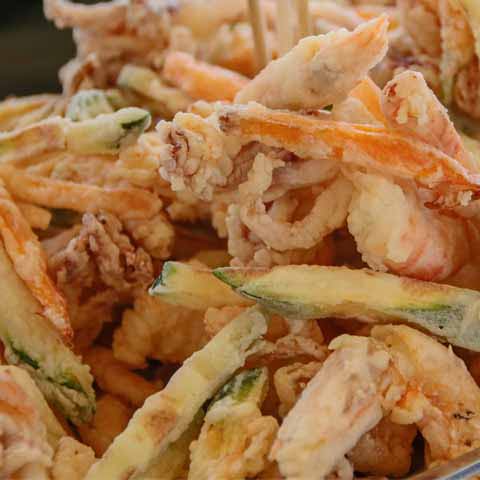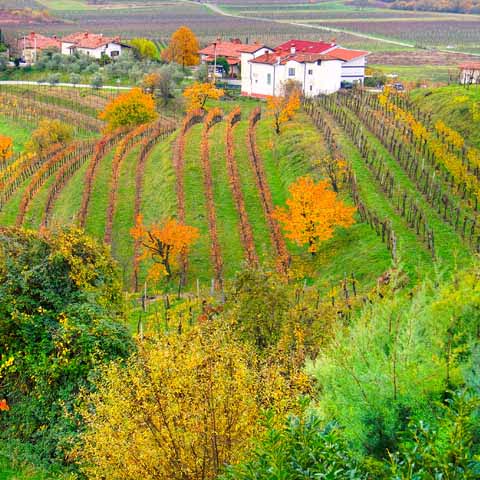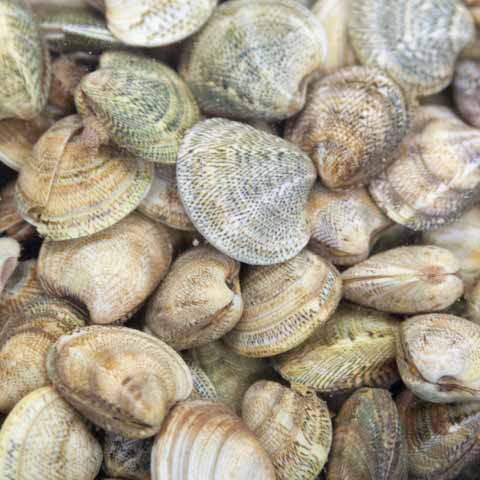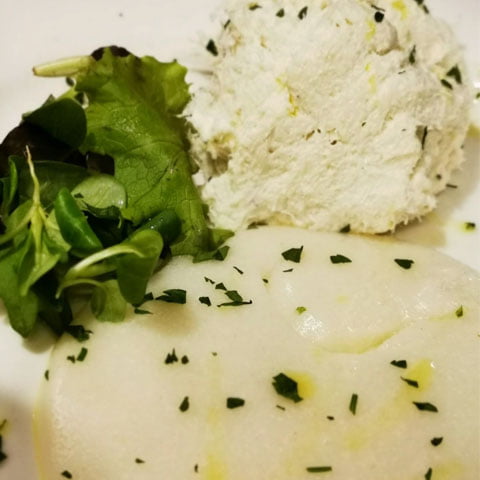Though nowadays officially part of Italy, the Friuli Venezia Giulia region has long served as a hub for different Central European cultures. This, coupled with the influence of nearby Austria and Slovenia, has greatly impacted the city of Trieste in everything from culture to cuisine. Fortunately, this blend of influences makes for some delicious cuisine, unlike what you will find almost anywhere else in Italy.
The one thing the food of Trieste does have in common with other Italian dishes is the way it is consumed. Here, eating is not simply feeding the body, it is a nourishing experience for the body and soul. Meals are always relished leisurely and are best enjoyed with a glass of locally made wine amongst the company of friends and family.
With a prime location along the Gulf of Trieste and the Adriatic Sea, the city of Trieste has many seafood-based regional favorites. Some of the more traditional dishes include puréed stockfish on toast, sautéed sardines, goulash, cabbage rolls, and locally made meats and cheeses.
In many parts of Trieste, the restaurants serve food buffet style. It is an important distinction to make that although served on a buffet, the food you will find there is the exact same caliber of slowly made and well flavored dishes that are offered in a table service restaurant. The food is also consumed at the same leisurely pace as a sit-down dinner, the only difference is the manner in which the food is served.
An experience unique to Trieste is the osmizze. These are a kind of food stand that sells home produced cheeses and hams and sometimes wine. Osmizze were established in part because of an Imperial decree in the late eighteenth century that allowed peasants from the Carso Plateau to sell produce for eight days of the year.
Bottom line, no matter where or how you eat in the enchanting city of Trieste, you are bound to enjoy the locally made meats and cheeses and freshly caught seafood all complemented by a glass of chilled Italian wine and possibly topped off with some of the best coffee in all of Italy.
APPETIZERS
Despite all of Trieste’s Austrian and Slovenian influences, as with almost any Italian city you will visit, Trieste typically serves warm, homemade bread. It can be offered on its own, along with cured meats and cheeses, or even with a bowl of steaming soup.
In Trieste, locals usually enjoy Sauris smoked ham, Prosciutto di San Daniele, and Montasio cheese. Both Sauris and Prosciutto di San Daniele are popular regionally made meats that are so tasty they are often exported and are internationally famous. Montasio cheese is made from cow’s milk and is served fresh or sometimes aged, which can give it a firmer texture.
A more unusual fare for appetizers is brovada. This dish is made of autumn turnips soaked in wine lees for about a month before they are shredded and cooked, sometimes with herbs and pork meat.
FIRST COURSE
In Trieste, many of the first courses are soup or pasta based. Jota soup, a local favorite, is made with boiled cabbage and beans and has been a staple in the area for more than 500 years. To enhance the flavor, it is not unusual for cooks to use smoked pork, sausage, or even potatoes to make the dish heartier. Traditionally, leftover pork, if available, was added to provide additional sustenance. Another often requested soup is brodetto. This seafood-based soup is generally a mixture of minced onions and garlic, olive oil, wine, and a variety of fish including mussels, red rock fish, eel, mullet, and sole.
Also prevalent in Trieste is minestra de bisi, a simple soup made with dried peas. The soup was inherited from the Austrian tradition in which it is called bunkersuppe, due to the fact that it was often served to Austrian soldiers while in trenches (bunkers).
A similar pea soup, called risi e bisi, derives from Veneto’s regional cuisine. The dense soup is made with rice and peas and is commonly enjoyed during the spring.
In Trieste, one of the most popular forms of pasta is gnocchi and it is usually served stuffed or breaded. Gnocchi de susini is definitely sweeter than savory as it is gnocchi cooked with fruit such as plums, eggs, cinnamon, and sugar. Breaded gnocchi is also popular and can be served with fried anchovies called sardoni or in goulash. Another variation is gnocchi stuffed with apricots, browned butter, and cinnamon. There is no limit to the imagination when creating these gnocchi dishes.
Though not as popular or perhaps as requested, there is pasta in Trieste that is not gnocchi. One of those dishes is cjarsòns. This dish is similar to ravioli that are stuffed with various herb mixtures.
SECOND COURSE
Much of the second course fare in Trieste is seafood based. With a prime location along the Gulf of Trieste and the Adriatic Sea, a variety of fish are available, in abundance, and always fresh. Throughout the city one can find clams, mussels, cuttlefish, tuna, and bass prepared in a number of different ways in many uniquely local dishes.
One of the more commonly requested seafood dishes in Trieste is sardoni. This dish consists of large sardines that are typically breaded or fried. Sardoni is said to be especially tasty when seasoned and fried with an onion and vinegar marinade. Also popular are stewed cuttlefish served with polenta and fritto misto, a fried combination of squid, shrimp, and other seafood.
Meat based dishes are also common for second course fare. Most often this includes stove-boiled pork or cooked ham. Calandraca is a commonly served meat-based stew made of beef simmered with potatoes and other vegetables. A simple dish historically prepared by poorer populations of the area, sailors would often prepare this dish as well with dried and salted meats during their voyages at sea.
A common vegetarian second course dish is rotolo di spinaci in straza. This dish consists of a mixture of spinach, ricotta, eggs, and cheese that is stuffed inside dough and formed into a roll before being baked.
SIDE DISHES
As with the rest of the country, potatoes and vegetables reign supreme in Trieste’s side dishes. One of the more popular local side dishes is known as capuzi garbi. Consisting of pickled cabbage similar to sauerkraut, capuzi garbi can be added to dishes, such as jota, right after the fermentation process is complete, or it may be cooked in water then sauteed in lard prior to serving (called capuzi garbi in tecia). In addition to jota, capuzi garbi is often served with pork.
Another local side dish is chifeletti, which is made from mashed potatoes mixed with flour, butter, and eggs.
STREET FOODS
Because the internationally famous Prosciutto di San Daniele and Prosciutto di Sauris are locally made, they are also local favorites. It is not uncommon to find these meats at food booths on the street.
Here you may also find frico, a delicious bite-sized piece of fried Montasio cheese and potato whose shape is reminiscent of a potato chip. The fried cheese chips are sometimes served in a long paper cone so consumers can eat on the go with ease.
DESSERT
The number of desserts in Trieste are almost as numerous and plentiful as the fish in the Adriatic Sea. Although sometimes these are served at the end of the meal, they can also be a delightful mid-day treat. The streets of Trieste are lined with historical and elegant cafes that visitors say make some of the best coffee and cappuccino in all of Italy, thanks to the thriving local coffee industry. Many of these cafés also have a small display case stocked with delicious desserts that just seem to taste better when enjoyed with a steaming cup of Trieste coffee.
The presnitz, putizza, and pinza are considered to be some of Trieste’s most famous desserts. All cakes, each of them are typically served during the Easter or Christmas holidays. These sweet breads are generally made with all kinds of sweet and flavorful treats such as raisins, walnuts, pine nuts, and others folded right into the dough before baking. Presnitz is prepared in a coiled shape with a sweet stuffing, while putizza is a nut roll that is usually served in slices and pinza is a dense cake with a sweet filling topped with powdered sugar.
Somewhat similar to these breads, but still totally different is Trieste’s apple strudel, called strucolo de pomi by the locals. Much like the bread, the strudel is filled with pine nuts and raisins. However, when it comes to fruit, apples get all the glory here. If traveling throughout the region of Friuli Venezia Giulia, apple strudel tends to be personalized differently depending on which city you are visiting.
WINE
The Friuli Venezia Giulia region is home to many fine wines, but perhaps the most locally preferred is Friulano. This white wine is often favored in Trieste and other cities primarily because of its local roots and light taste.
In the Friuli Venezia Giulia region as a whole, of which Trieste is a part of, much of the wine comes from the Carso region which is nearby to the city. The Terrano wine from Carso is also a preferred wine largely because of its local roots. Other wines from the region include Refosco, Pinot Bianco, and Sauvignon Blanc.
No matter which wine you choose to complement your meal, any of the above are considered among Italy’s finest and will not disappoint when enjoyed with good friends and family.
With cultural ties to Austria and Slovenia that remain strong to this day, Trieste’s status as a crossroads between Italy and Central Europe is highly evident in the local cuisine. A visit to Trieste is an excellent chance to sample some of the most unique food in the country, such as gnocchi de susini, calandraca, frico, presnitz, and much more.
Don't just see Italy, live it.
Your dream trip to Italy has never been closer
No more endlessly scrolling travel sites. Our travel experts will craft the perfect, one-of-a-kind trip just for you.

300+
DESTINATIONS
We offer more Italian destinations than any travel site. Do and see more with Trips 2 Italy.
1 (of a kind)
ITINERARIES
Because your dream trip to Italy should be designed for you, not for the masses.
100%
PEACE OF MIND
From flights and accommodations, to food and activities - we take care of every detail.
